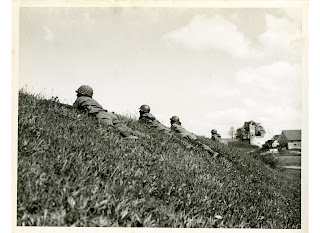The Last Days of the Dachau Concentration Camp
The historic winter of 1944-45 tested the endurance of the Dachau concentration camp’s captive population. News, much of it good, about the Allies’ recent triumphs —stopping Adolf Hitler’s Ardennes Offensive and the unleashing of the Red Army’s Vistula-Oder Offensive (mid-January 1945)—seeped in. As the weeks passed, confidence in Allied victory, while fragile, struck roots in Dachau.
There were powerful reasons for inmates, though, to temper expectations. Despite the fragmentary knowledge of the state of the war they gained, there was much uncertainty about how long the Hitler regime might withstand the Allied advance. Due to its location in Bavaria, quite distant from the battle fronts, liberation would not happen anytime soon. Undoubtedly, the omnipresence of the SS guaranteed that attempted escape or rebellion would be met with extreme violence.
Other factors besides the SS’s wanton cruelty incited new terror among Dachau’s prisoners. Food supplies dwindled just as thousands of arrivals evacuated from other camps had to be fed. In short order, overcrowding, disease (particularly typhus), and malnutrition followed the bitter cold of winter. Deaths in the camp soared.
Some perspective is needed to comprehend the skyrocketing mortality rate in Dachau. Harold Marcuse’s Legacies of Dachau offers us that. Looking back to the beginning of World War II, he contends that between 1,000 and 3,000 prisoners perished in the camp, annually, between 1940 and 1943. Twice in those three years, the death toll surpassed 400 per month. In the autumn of 1944 a dreadful transition occurred. The numbers who died topped 400 in October, then doubled in November, before reaching 1,915 in December.
Dachau’s final four months of operation in 1945 proved truly catastrophic. Between 2,600 and 4,000 inmates per month succumbed to disease or starvation, roughly 100 every day. With the camp suffering from a shortage of coal since late 1944, the crematoria could not keep pace with the tempo of dying. In response, the SS authorities at Dachau forced prisoners to bring the dead to a hill located close to the camp and bury them in a pit.
As spring began, word reached Dachau that US troops had seized a bridge over the Rhine River at Remagen in early March. Americans now pushed deep into Germany. Munich, the capital of Bavaria and birthplace of National Socialism, was a major target. How long before the Americans reached Dachau?
Unsurprisingly, rumors, terrible rumors, swirled around the camp. The prospect of evacuation to an uncertain locale loomed, a terrifying prospect given the deteriorating physical condition of the inmates. One of the most frightful disseminated involved the SS liquidating all the prisoners rather than see them liberated. An atmosphere of constant apprehension reigned.
The sense of fear escalated horribly in early April. On April 9, the Nazis put to death Georg Elser, the cabinetmaker whose bomb placed in Munich’s Bürgerbräukeller just missed killing Hitler on November 8, 1939 (the dictator abruptly departed the commemoration of the Beer Hall Putsch minutes before the device detonated). Elser, who had only recently been transferred to Dachau after spending much of the war in the Sachsenhausen concentration camp, was executed with a shot in the back of the neck on the orders of Heinrich Himmler. Himmler commanded that responsibility for Elser’s death be attributed to a raid by the Royal Air Force.
In a few cases, the SS decided to quickly relocate high-profile prisoners, such as Léon Blum, the socialist politician and one-time prime minister of France, the right-wing politician and former Chancellor of Austria, Kurt von Schuschnigg, and the pastor and theologian Martin Niemöller.
Chaos, however, ruled inside Dachau by mid-April 1945. Transports came bearing thousands of emaciated inmates from Buchenwald, Flossenbürg, and the sub-camps of Natzweiler-Struthof, all threatened by the rapid advance of Allied armies. This influx simply overwhelmed Dachau’s capacities. Commandant Eduard Weiter underwent a nervous breakdown. Consequently, Berlin called in Martin Weiss, the former commandant from 1942-43 with a reputation for benevolence among the inmates, to restore some semblance of order and discipline. Weiss initiated communication with Victor Maurer, a representative of the International Red Cross. Maurer was permitted to bring parcels for the inmates but barred from actually inspecting the camp.




Comments
Post a Comment